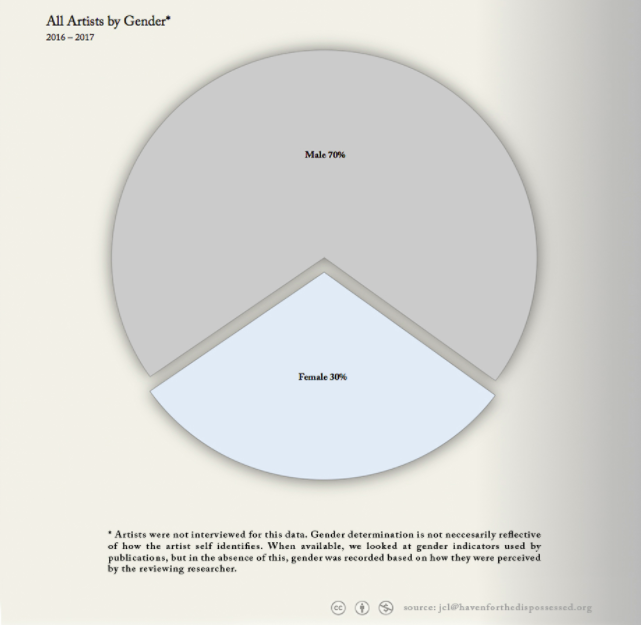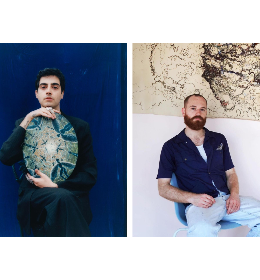Every Monday Tim Schneider, Director of Research at Kayne Griffin Corcoran Gallery and the brains behind The Gray Market Blog, dissects the most important stories of the week from the art market.
THE SUN ALSO RISES
On Wednesday, we in the art media caught wind of a new buffet of gallery-sector data, all served up by an unexpected source: CUNY Guttman professor James Case-Leal and the undergrads in his Spring 2017 course "Arts in NYC." Somewhat grandiosely dubbed “Haven for the Dispossessed”, the online home for the collected numbers charts the age, race, gender, nationality, and education of roughly 1,300 living artists represented by what Case-Leal deemed the "top 45 commercial galleries in New York," circa autumn 2016.
The headline results likely reinforce, if not further depress, the already-low expectations of practically anyone who hasn't spent 2017 hiding inside a warm, cozy pouch of altered reality like a baby marsupial. The surveyed rosters were originally said to be 80.5 percent white, 70 percent male, and 46.9 percent MFA-holding. The study also laid bare several per-gallery statistics more embarrassing than an audible orgasm one wall away from your in-laws. Just consider that 6 of the 45 galleries in the cohort somehow managed not to represent a single non-white artist during the data-collection period. As my dad would say: Yikes.
Now, there were flaws in Case-Leal's initial numbers to be sure. For instance, Hyperallergic's Hrag Vartanian pointed out that the respective ethnicities of Brad Kahlhamer (of Native American descent) and Walid Raad (of Middle Eastern descent) were both misclassified in the data upon release. The artist collective Slavs and Tatars mentioned — apparently, citing a Facebook post by Hito Steyerl — that Liam Gillick was originally listed as a woman, Isaac Julien was originally mischaracterized as white, and Tacita Dean was originally misidentified as male. I even emailed Case-Leal myself on Saturday to let him know that Japanese artist Tomoo Gokita's gender had been inverted in his spreadsheet, too.
However, despite what longtime readers might expect, the last thing I want to do is crucify this study on a Volkswagen like it was 1974 Chris Burden, for two main reasons.
First, as Case-Leal clarified in a June 3rd update/correction of the initial results, his entire operation consisted of a part-time adjunct professor and a class of undergrad students at a modest public university, with no outside support. Placing “Haven for the Dispossessed” side by side with the resources surrounding annual reports from the likes of Art Basel/UBS and TEFAF would be like comparing apples to Macbook Pros.
Second, Case-Leal did with his gallery/dealer sector data what those other two often-cited studies still have not: published the raw numbers for outside scrutiny. True, Clare McAndrew and Rachel Pownall attempted to cover vastly more — and vastly more secretive — ground with their respective 2017 art-market reports than “Haven for the Dispossessed”, which strictly drew on public information about a deliberately narrow scope of questions. But when it comes to their private-market numbers, the most recent editions of The Art Market and TEFAF largely remain black boxes, if not black holes.
In contrast, I'd argue that the initial errors in Case-Leal's study ultimately represent virtues, not vices. Why? Because we, the public, were actually given the opportunity to inspect and correct them. That's a rare privilege in the province of art-industry data, even at the highest level.
So rather than throw shade at “Haven for the Dispossessed” for mis-keying or misinterpreting an estimated 0,3 percent of its data off the bat, let's celebrate the sunlight that Case-Leal and his students allowed into this corner of the market — and hope that the professional quants behind the biggest, boldest data initiatives in the industry recognize the value in mirroring it back sometime soon. [Haven for the Dispossessed]

PARKS & DRECK
Wednesday also saw the peaceful resolution of the latest scandal around an artwork accused of cultural insensitivity, as the Walker Art Center announced that it had agreed to allow members of the Dakota tribal community to remove and ceremonially burn Sam Durant's Scaffold (2012), an intended new addition to the institution's sculpture park. As my colleague Sarah Cascone explained, Scaffold ignited this controversy by "[drawing] on the gallows built for seven major executions in US history, including the largest mass execution ever to take place in the US, which killed 38 Dakota Indians in 1862 in nearby Mankato, Minnesota" — a fact that basically everyone involved with the piece's creation and acquisition has now publicly recognized as, you know, kind of a major problem in 2017.
However, what caught my eye about this story was a passing detail about the future. During the joint press conference announcing the mediated solution, Walker executive director Olga Viso clarified that the institution had acquired the work without seeking the blessing of the Minneapolis parks department. Soon after, a parks department rep apparently "suggested that this arrangement would likely change in the wake of the controversy."
With all due respect to the public servants of Minneapolis, this strikes me as both an ethically and aesthetically dubious response to the Walker's error, severe as it was. First, let's not pretend that municipal-government bodies in the US have some kind of sterling track record as failsafes against the erection of culturally offensive public sculptures. I can think of at least 700 glaring failures off the top of my head. So count me as skeptical of the idea that the Minneapolis parks department would be an automatic firewall against future artwork-driven scandals.
That leaves the aesthetic side of the equation. Personally, nothing makes my antennae spring up faster than hearing that major artworks will be selected by a committee overseen by art agnostics. (or worse) If the Walker indeed subordinates future acquisitions to the parks department, might it also doom great works that are just plain challenging, un-intuitive, or unexpected? For instance, would Martin Puryear's Gog & Magog (Ampersand) (1987-88) exist at the Walker today if the deputy superintendent of parks thought that its twin granite cones looked so much like giant dunce caps that they could inadvertently convince tourists to associate the Twin Cities with low IQ?
That's an admittedly extreme example conjured by a still-hypothetical response to a legitimately gross error. Still, it highlights how quickly curating can descend into absurdity when consensus taste becomes a priority. Going forward, it's at least remotely possible that granting veto power to the parks department could safeguard and mainstream the Walker's outdoor-sculpture collection into mediocrity. That may not be as much of a shame as the real distress caused by Scaffold. But it won't necessarily make either the Walker or the Minneapolis community better off, either. [artnet News]

Sam Durant, Scaffold. Courtesy of Sarah Cascone
A.D.I.D.A.S. (ALL DAY I DREAM ABOUT STATUS)
Finally this week: On Tuesday, Art Basel's attorneys stepped into Florida federal court to sue global apparel giant Adidas for copyright infringement and a Swiss army knife of related charges. At issue was Adidas' alleged November 2016 manufacture and promotion of 1,000 limited-edition pairs of its EQT sneakers, all with Art Basel's registered trademark on the tongue and tags — and all without the permission of either the fair or its parent company, the MCH Group. Per Isaac Kaplan, the plaintiffs are seeking "treble damages, the destruction of the 'offending' shoe and other material, and other relief," which I sincerely hope includes forcing Adidas to somehow remind the world that nü-metal relics Korn used the brand's name as the titular acronym for a regrettable 2009 single about compulsive masturbation.
Let's step away from the legal minutiae to consider the bigger picture, though: Adidas, which last year did around $20 billion in sales en route to becoming the second-largest and almost indisputably edgiest sportswear brand on the planet, seems to have thought that Art Basel's name and logo had enough pop-cultural cachet to generate major buzz in the style-obsessed sneakerhead community. In fact, if Art Basel and MCH's complaint is as much of a slam dunk as it looks like from the initial reports, Adidas was so thirsty for the association that it was willing to blatantly violate trademark statutes to try to establish it.
In terms of contemporary art's footprint on the zeitgeist, I would argue that this is significant on its own. But it becomes even more noteworthy if we remember what Art Basel is (and isn't). This is not a case of a mainstream brand co-opting artists (done), museums (done), or even galleries (done). Instead, whether lawfully or unlawfully, what Adidas tried to leverage here was a TRADE SHOW. On paper, it should have been little more valuable than if the Three Stripes jacked the branding for the Consumer Electronics Show, International Woodworking Fair, or the nonstop annual thrill-fest that is World of Concrete.
The key, however, is that those comps disintegrate when we move from the theoretical realm into 21st-century reality. Due to a whole constellation of factors, today Art Basel signifies more than just a trade show, more than just an industry-specific event, and more than just artwork. To the broader culture, it now signifies an aspirational lifestyle — and with it, a level of status that everyone from rappers to actors to athletes wants to get in on.
So to a multibillion-dollar apparel titan competing for market share by chasing the cool, would the buzz achievable by infringing on Art Basel's logo in the lead-up to Miami be worth throwing away maybe a few hundred thousand bucks in court a few months later?
Before you make up your own mind, consider that the brand's fall 2016 ad campaign — the one running during the release of the "offending shoe" — was titled "Sports Needs Creators." Coincidence? Only Adidas can say for sure. [Artsy]

That’s all for this edition. Til next time, remember: There's a thin line between preference and prejudice. Keep your eyes open.









